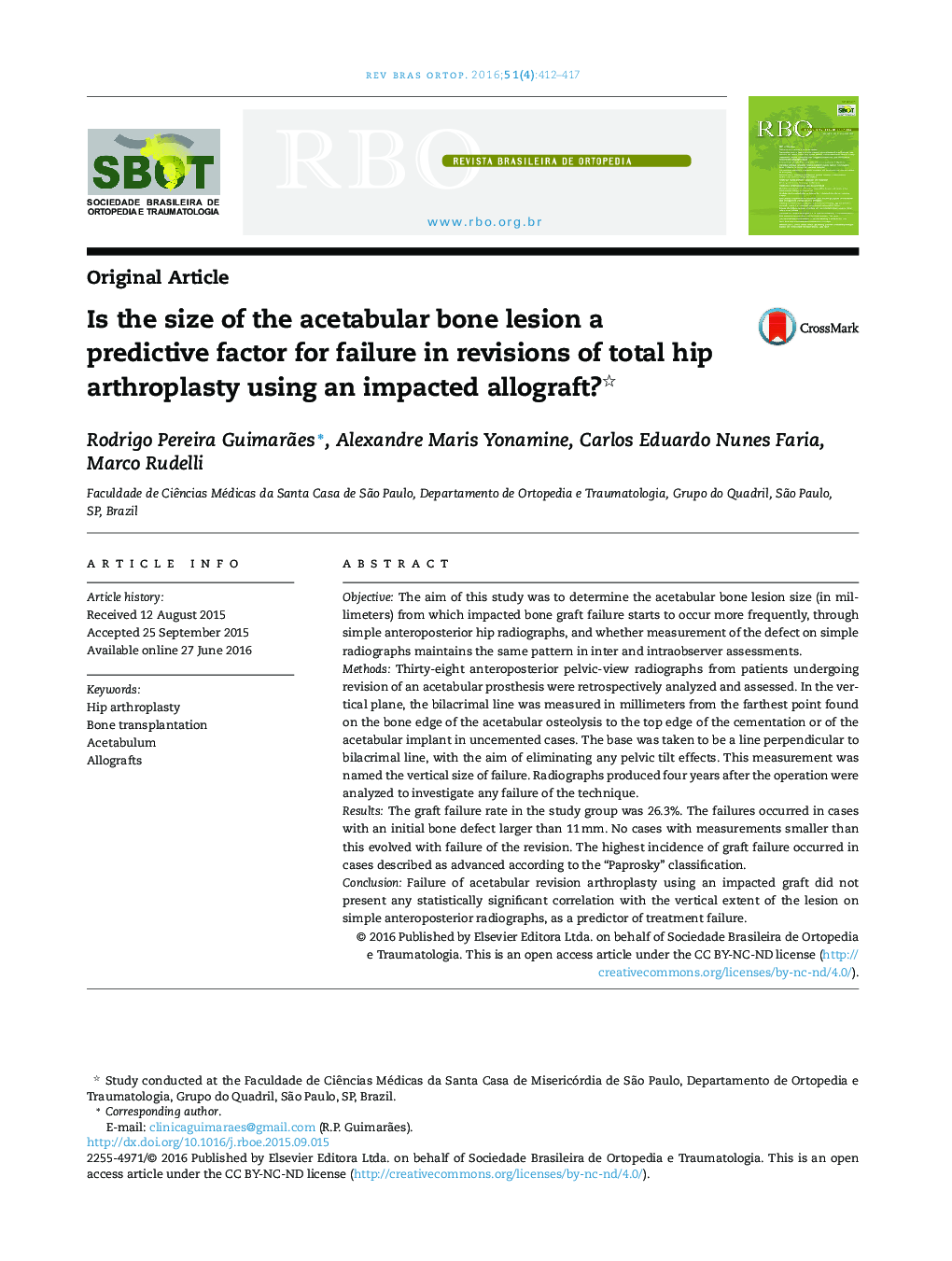| کد مقاله | کد نشریه | سال انتشار | مقاله انگلیسی | نسخه تمام متن |
|---|---|---|---|---|
| 2707816 | 1565452 | 2016 | 6 صفحه PDF | دانلود رایگان |
ObjectiveThe aim of this study was to determine the acetabular bone lesion size (in millimeters) from which impacted bone graft failure starts to occur more frequently, through simple anteroposterior hip radiographs, and whether measurement of the defect on simple radiographs maintains the same pattern in inter and intraobserver assessments.MethodsThirty-eight anteroposterior pelvic-view radiographs from patients undergoing revision of an acetabular prosthesis were retrospectively analyzed and assessed. In the vertical plane, the bilacrimal line was measured in millimeters from the farthest point found on the bone edge of the acetabular osteolysis to the top edge of the cementation or of the acetabular implant in uncemented cases. The base was taken to be a line perpendicular to bilacrimal line, with the aim of eliminating any pelvic tilt effects. This measurement was named the vertical size of failure. Radiographs produced four years after the operation were analyzed to investigate any failure of the technique.ResultsThe graft failure rate in the study group was 26.3%. The failures occurred in cases with an initial bone defect larger than 11 mm. No cases with measurements smaller than this evolved with failure of the revision. The highest incidence of graft failure occurred in cases described as advanced according to the “Paprosky” classification.ConclusionFailure of acetabular revision arthroplasty using an impacted graft did not present any statistically significant correlation with the vertical extent of the lesion on simple anteroposterior radiographs, as a predictor of treatment failure.
ResumoObjetivoO presente trabalho buscou, através de uma radiografia simples anteroposterior do quadril, quantificar em milímetros a partir de qual tamanho da lesão óssea acetabular ocorre com maior frequência falha do enxerto ósseo impactado e se a medição do defeito nas radiografias simples mantém o mesmo padrão na avaliação inter e intraobservador.MétodosForam analisadas e aferidas retrospectivamente 38 radiografias de pacientes submetidos à revisão de prótese acetabular na incidência anteroposterior de bacia, mensurando em milímetros, no plano vertical a linha bilacrimal, a medida entre o ponto mais distante encontrado na borda óssea da osteolise acetabular, com a margem superior da cimentação ou implante acetabular nos casos não cimentados. Tomamos como base uma linha perpendicular a linha bilacrimal com o intuito de eliminar efeitos de inclinação pelvic. Essa medida foi denominada Tamanho Vertical da Falha. Radiografias pós-operatórias com quatro anos foram analisadas para averiguar falha da técnica.ResultadosNo grupo estudado observamos 26,3% de falhas do enxerto que ocorreram a partir de 11 mm de tamanho da falha óssea inicial mensurada e que abaixo desse valor nenhum caso evoluiu com falha da revisão. A maior incidência da falha do enxerto ocorreu nos casos avançados segundo a classificação de Paprosky.ConclusãoA falha na artroplastia de revisão acetabular com enxerto impactado quando relacionado à medida vertical da lesão em radiografia simples anteroposterior do quadril não apresentou significância estatística como fator preditivo de falha do tratamento.
Journal: Revista Brasileira de Ortopedia (English Edition) - Volume 51, Issue 4, July–August 2016, Pages 412–417
